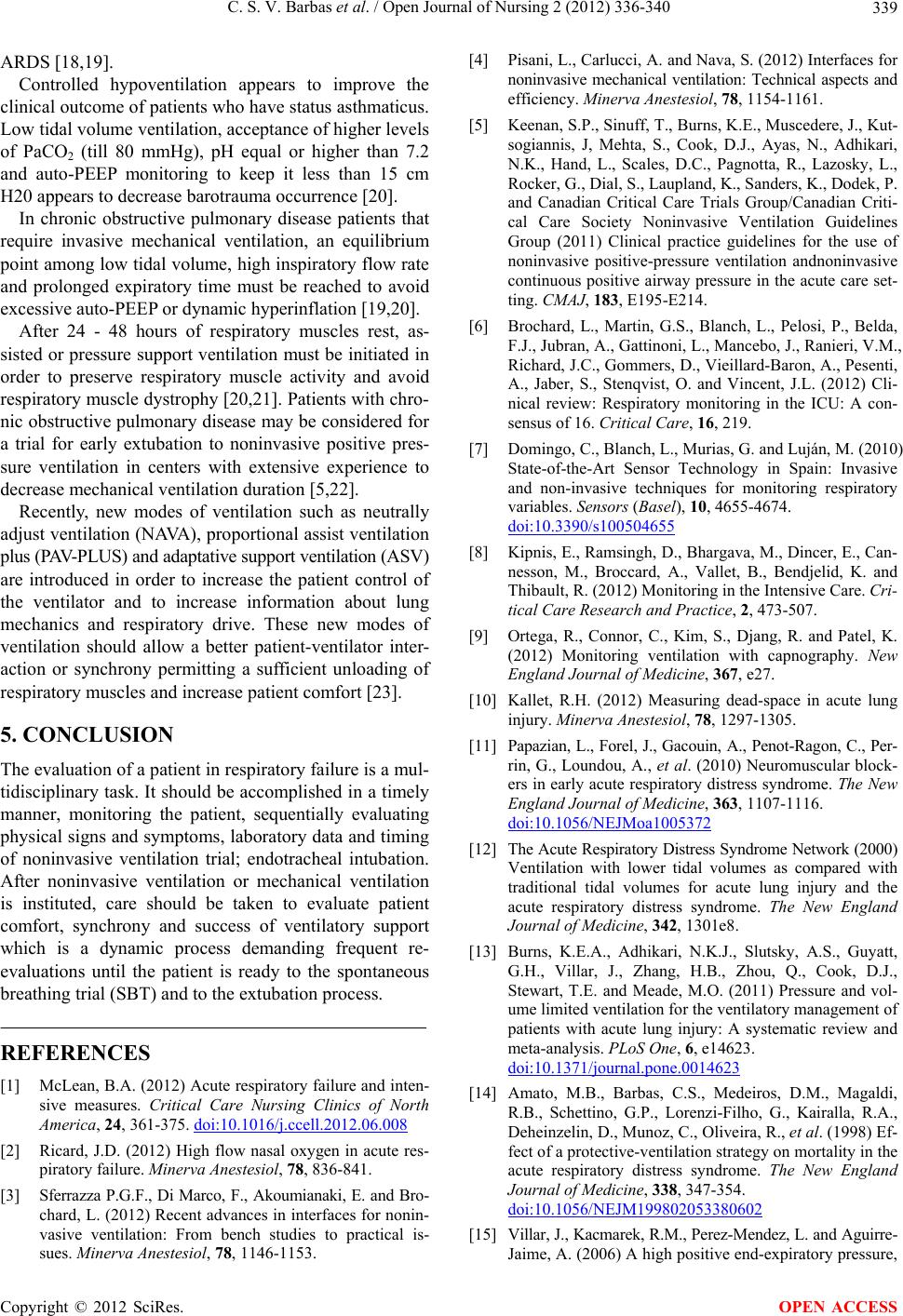
C. S. V. Barbas et al. / Open Journal of Nursing 2 (2012) 336-340 339
ARDS [18,19].
Controlled hypoventilation appears to improve the
clinical outcome of patients who have status asthmaticus.
Low tidal volume ventilation, acceptance of higher levels
of PaCO2 (till 80 mmHg), pH equal or higher than 7.2
and auto-PEEP monitoring to keep it less than 15 cm
H20 appears to decrease barotrauma occurrence [20].
In chronic obstructive pulmonary disease patients that
require invasive mechanical ventilation, an equilibrium
point among low tidal volume, high inspiratory flow rate
and prolonged expiratory time must be reached to avoid
excessive auto-PEEP or dynamic hyperinflation [19,20].
After 24 - 48 hours of respiratory muscles rest, as-
sisted or pressure support ventilation must be initiated in
order to preserve respiratory muscle activity and avoid
respiratory muscle dystroph y [20,21]. Patients with chro -
nic obstructive pulmonary disease may be considered for
a trial for early extubation to noninvasive positive pres-
sure ventilation in centers with extensive experience to
decrease mechanical ventilation duration [5,22].
Recently, new modes of ventilation such as neutrally
adjust ventilation (NAVA), proportional assist ventilation
plus (PAV-PLUS) and adaptative support ventilation (ASV)
are introduced in order to increase the patient control of
the ventilator and to increase information about lung
mechanics and respiratory drive. These new modes of
ventilation should allow a better patient-ventilator inter-
action or synchrony permitting a sufficient unloading of
respiratory muscles and increase patient comfort [23].
5. CONCLUSION
The evaluation of a patient in respirator y failure is a mul-
tidisciplinary task. It should be accomplished in a timely
manner, monitoring the patient, sequentially evaluating
physical signs and symptoms, laboratory data and timing
of noninvasive ventilation trial; endotracheal intubation.
After noninvasive ventilation or mechanical ventilation
is instituted, care should be taken to evaluate patient
comfort, synchrony and success of ventilatory support
which is a dynamic process demanding frequent re-
evaluations until the patient is ready to the spontaneous
breathing trial (SBT) and to the extubation process.
REFERENCES
[1] McLean, B.A. (2012) Acute respiratory failure and inten-
sive measures. Critical Care Nursing Clinics of North
America, 24, 361-375. doi:10.1016/j.ccell.2012.06.008
[2] Ricard, J.D. (2012) High flow nasal oxygen in acute res-
piratory failure. Minerva Anestesiol, 78, 836-841.
[3] Sferrazza P.G.F., Di Marco, F., Akoumianaki, E. and Bro-
chard, L. (2012) Recent advances in interfaces for nonin-
vasive ventilation: From bench studies to practical is-
sues. Minerva Anestesiol, 78, 1146-1153.
[4] Pisani, L., Carlucci, A. and Nava, S. (2012) Interfaces for
noninvasive mechanical ventilation: Technical aspects and
efficiency. Minerva Anestesiol, 78, 1154-1161.
[5] Keenan, S.P., Sinuff, T., Burns, K.E., Muscedere, J., Kut-
sogiannis, J, Mehta, S., Cook, D.J., Ayas, N., Adhikari,
N.K., Hand, L., Scales, D.C., Pagnotta, R., Lazosky, L.,
Rocker, G., Dial, S., Laupland, K., Sanders, K., Dodek, P.
and Canadian Critical Care Trials Group/Canadian Criti-
cal Care Society Noninvasive Ventilation Guidelines
Group (2011) Clinical practice guidelines for the use of
noninvasive positive-pressure ventilation andnoninvasive
continuous positive airway pressure in the acute care set-
ting. CMAJ, 183, E195-E214.
[6] Brochard, L., Martin, G.S., Blanch, L., Pelosi, P., Belda,
F.J., Jubran, A., Gattinoni, L., Mancebo, J., Ranieri, V.M.,
Richard, J.C., Gommers, D., Vieillard-Baron, A., Pesenti,
A., Jaber, S., Stenqvist, O. and Vincent, J.L. (2012) Cli-
nical review: Respiratory monitoring in the ICU: A con-
sensus of 16. Critical Care, 16, 219.
[7] Domingo, C., Blanch, L., Murias, G. and Luján, M. (2010)
State-of-the-Art Sensor Technology in Spain: Invasive
and non-invasive techniques for monitoring respiratory
variables. Sensors (Basel), 10, 4655-4674.
doi:10.3390/s100504655
[8] Kipnis, E., Ramsingh, D., Bhargava, M., Dincer, E., Can-
nesson, M., Broccard, A., Vallet, B., Bendjelid, K. and
Thibault, R. (2012) Monitoring in the Intensive Care. Cri-
tical Care Research and Practice, 2, 473-507.
[9] Ortega, R., Connor, C., Kim, S., Djang, R. and Patel, K.
(2012) Monitoring ventilation with capnography. New
England Journal of Medicine, 367, e27.
[10] Kallet, R.H. (2012) Measuring dead-space in acute lung
injury. Minerva Anestesiol, 78, 1297-1305.
[11] Papazian, L., Forel, J., Gacouin, A., Penot-Ragon, C., Per-
rin, G., Loundou, A., et al. (2010) Neuromuscular block-
ers in early acute re spiratory distress syndrome. The New
England Journal of Medicine, 363, 1107-1116.
doi:10.1056/NEJMoa1005372
[12] The Acute Respiratory Distre ss Syndrome Netwo rk (2000)
Ventilation with lower tidal volumes as compared with
traditional tidal volumes for acute lung injury and the
acute respiratory distress syndrome. The New England
Journal of Medicine, 342, 1301e8.
[13] Burns, K.E.A., Adhikari, N.K.J., Slutsky, A.S., Guyatt,
G.H., Villar, J., Zhang, H.B., Zhou, Q., Cook, D.J.,
Stewart, T.E. and Meade, M.O. (2011) Pressure and vol-
ume limited ventilation for the ventilatory management of
patients with acute lung injury: A systematic review and
meta-analysis. PLoS One , 6, e14623.
doi:10.1371/journal.pone.0014623
[14] Amato, M.B., Barbas, C.S., Medeiros, D.M., Magaldi,
R.B., Schettino, G.P., Lorenzi-Filho, G., Kairalla, R.A.,
Deheinzelin, D., Munoz, C., Oliveira, R., et al. (1998) Ef-
fect of a protective-ventilation strategy on mortality in the
acute respiratory distress syndrome. The New England
Journal of Medicine, 338, 347-354.
doi:10.1056/NEJM199802053380602
[15] Villar, J., Kacmarek, R.M., Perez-Mendez, L. and Aguirre-
Jaime, A. (2006) A high positive end-expiratory pressure,
Copyright © 2012 SciRes. OPEN ACCESS